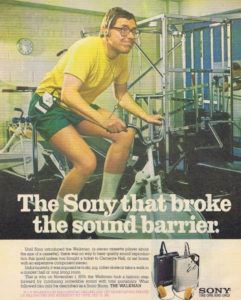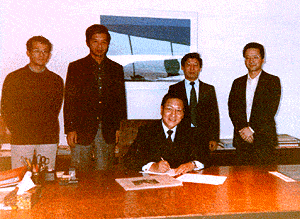Sony’s struggle with Music

Sony is a household name when it comes to entertainment – films, TV, music, video games, you name it. But for some reason Sony’s becoming an antiquated name and doesn’t show up in the new digital music space. What happened?
Sony and Music
In 1979, Sony invented the Walkman. Since then, Sony has become a leader in the intersection of music and technology – the 1980s became known as the “Walkman decade”(1), with the word “Walkman” entering the Oxford English Dictionary in 1986.(1) In 1988 Sony acquired Columbia Broadcasting System Records Inc. (CBS), and renamed it Sony Music Entertainment.(2) With this acquisition, Sony started to increase its presence in the entertainment industry.

Figure 1: Sony’s Walkman Advertisement

Figure 2: Sony acquires CBS Records
Digital Music
Fast forward to 2010. Sony was now one of the major record companies in music, but its audio-tech business (under the Walkman brand name) was struggling. Although Sony owned the contents and hardware related to music, it was unable to synergize its businesses. Organizational silos made Sony late in the game with the digital portable music players – the launch of the iPod in 2001 made Sony lose its position in the portable music industry.(3) By 2010, digital music was growing in the music industry. The presence of Spotify and other digital music players completely shifted the business and operational model for Sony.
Digital music players created an online platform where users could listen to music through a subscription or free basis. For example, Spotify offered listeners a “free” service to listen to music.(4) Spotify wanted to offer an alternative option to listen to music in a time when piracy was becoming prevalent in the industry.(4) Rhapsody and other digital music platforms offered the subscription model, in which customers paid on a subscription basis to listen to music.(4) Spotify on the other hand provided the Freemium Model, in which users could use their services for free and charge customers for upgrades.(4) By late 2010, Spotify had 8 million subscribers and almost 1 million migrating up from the free customer tier to the paid tier.(4)
Attempt and Failure: Music Unlimited
To compete with these new players and to regain its leadership in the music industry, Sony introduced “Music Unlimited” in 2010.(5) Sony believed that they too could provide a music streaming service like its competitors but at an advantage given its rich resources in the music industry. With a subscription model, Music Unlimited charged its users $10 a month(6), provided users with unlimited listening and allowed them to make playlists.(7) Music Unlimited was accessed through Sony’s PlayStation Network (gaming, entertainment, and media platform) and offered its services to customers in 19 countries.(7)
Figure 3: Music Unlimited Advertisement
Unfortunately, Music Unlimited failed quickly. While competitors who used a similar subscription model offered its services through any devices, Music Unlimited was only available through Sony devices.(8) Many customers complained about its limited use as well as its long time in loading the application.(9) By 2015, Music Unlimited had only 20,000 subscribers – well below its competitors.(9)
Surrender and partner with Spotify
Figure 4: Spotify introducing its partnership with Sony
In 2015, Sony decided to end Music Unlimited and instead decided to partner with Spotify. Replacing Music Unlimited and now calling it “PlayStation Music”, Spotify would use Sony’s PlayStation Network.(9) This partnership defined Sony’s surrender in the digital music space. Andrew House, President of Sony Computer Entertainment and head of Sony’s Network Entertainment Business stated that “it became clear that it would be better for [the] unit to concentrate on service we have tremendous expertise in – which were videogame consoles rather than music subscription”.(6) For Spotify, this partnership meant that they would be able to tap into a new market through the PlayStation network which had 64 million active users as of 2015.(6)
Now what?
Sony’s failure with Music Unlimited is a clear depiction of how organizations in silos could fail miserably in the event of a business and operational model disruption in the industry. Despite having rich resources and assets in the entertainment industry, Sony was unable to conduct synergies and worked in silos – business division in portable music and in music were not communicating and working together. If they had leveraged its resources, Sony could have introduced the iTunes and iPod, and even Spotify to the world. Although Sony could no longer become a leader in the digital music space, they could make sure to never deleverage their resources like they have in the music industry. For instance, they could collaborate with Sony’s film production company (Sony Pictures Entertainment) and create exclusive contents like Tidal.(10) What Sony needs to do now is to understand what is coming after digital music streaming. Sony must figure out early on and hopefully this time they’ll get it right.
Word Count: 755
Sources:
- TIME.com. 2016. A Brief History of The Walkman – TIME. [ONLINE] Available at: http://content.time.com/time/nation/article/0,8599,1907884,00.html. [Accessed 18 November 2016].
- Sony Global – Sony History Chapter22 CBS/Sony Records is Established in First Round of Capital Deregulation. 2016. Sony Global – Sony History Chapter22 CBS/Sony Records is Established in First Round of Capital Deregulation. [ONLINE] Available at: https://www.sony.net/SonyInfo/CorporateInfo/History/SonyHistory/2-22.html. [Accessed 18 November 2016].
- Hiroko Tabuchi. 2016. How Sony Fell Behind in the Tech Parade – The New York Times. [ONLINE] Available at: http://www.nytimes.com/2012/04/15/technology/how-sony-fell-behind-in-the-tech-parade.html. [Accessed 18 November 2016].
- Dolan, Robert J. “The Birth, Life and Death of Rdio.” Harvard Business School Case 516-092, May 2016. (Revised August 2016.)
- The Guardian. 2016. Sony to expand music streaming service | Media | The Guardian. [ONLINE] Available at: https://www.theguardian.com/media/2011/jan/25/sony-music-unlimited-streaming-service. [Accessed 18 November 2016].
- Hannah Karp. 2016. Sony Bails Out of Music Streaming – WSJ . [ONLINE] Available at: http://www.wsj.com/articles/sony-bails-out-of-music-streaming-1422481528. [Accessed 18 November 2016].
- The Guardian. 2016. Sony to expand music streaming service | Media | The Guardian. [ONLINE] Available at: https://www.theguardian.com/media/2011/jan/25/sony-music-unlimited-streaming-service. [Accessed 18 November 2016].
- TechHive. 2016. Sony’s Music Streaming Service: What Were They Thinking?! | TechHive. [ONLINE] Available at: http://www.techhive.com/article/220002/sonys_music_streaming_service_what_were_they_thinking.html. [Accessed 18 November 2016].
- New York Times. 2016. New York Times. [ONLINE] Available at: http://www.nytimes.com/2015/01/29/business/media/sony-teams-spotify-with-playstation-for-music-streaming-plans.html?_r=1. [Accessed 18 November 2016].
- The Hollywood Reporter. 2016. 8 Things on Jay Z’s Tidal Streaming Service That Aren’t on Spotify | Hollywood Reporter. [ONLINE] Available at: http://www.hollywoodreporter.com/news/8-things-jay-zs-tidal-785468. [Accessed 18 November 2016].





Given the profitability challenges of Spotify, Pandora, etc. do you think that Sony regrets missing the boat on streaming digital music? Clearly they would have been better off had they evolved more quickly to compete with Apple’s iTunes in the early 2000s but with the more recent developments in the music industry, are they really missing out on a desirable business or are they missing out on high costs in the name of uncertain growth?
Who do you think Sony views as its primary competition for long-term growth? Hardware companies like Samsung, LG, etc.? Or historically software focused companies like Google, Amazon, etc.? The answer to this question may help guide them to the appropriate strategy on attacking digital music in the future.
Thanks TN from this article. In my opinion, Sony is yet another example of how digitization fundamentally accelerates and intensify competitive dynamics. It took Sony less than 20 years to go from indisputable leader in the portable music space, to an unknown player. And Sony is not alone. Many other deeply established firms and industries fell to digital newcomers: Blockbuster vs. Netflix, Britannica Encyclopedia vs. Wikipedia, Taxis vs. Uber, etc… All these exemplify how a small and young start-up can come out of nowhere and snatch a market from its leader.
Although I agree with your view that cross-functional integration is important to take new digital opportunities, I also think that incumbent companies, like Sony, need to play defense as well. Companies like beer giant AB InBev, with its ZX Ventures program, have spend significant resources and talent into having internal innovation machines that are constantly seeking for new products and services, as well as monitoring the market for new companies that could disrupt their industry. Even if the company is too slow to react to the market, they could at least acquire newcomers and lead industry changes, instead of falling prey to them.
Interesting article! I wonder where Sony is going to focus on going forward, now given that large of of their business (the hardware) has been disintermediated by digital music platforms. Rather than thinking of new ways to provide value for consumers, I wonder if Sony should focus on providing more value for its “suppliers”, or the music makers in the industry. Because advanced recording equipment and software have made it possible for many music amateurs to produce music, I think there is a lot that Sony can do to capitalize on this market. For example, they could make it easier for these new artists to distribute its music online through its established network of music distributors, or creating online platforms that makes it easier for artists to produce or collaborate with others.
Great post – very interesting to see what can happen in such a short period of time if companies don’t get in front of, or at least respond to, digitization pressures. Given your experience, I would be curious about your thoughts on Sony’s Playstation Vue (i.e., TV packages trhough the internet) launch? My personal thinking is that while it appears that Sony may be getting ahead of the curve with this offering, I’m not sure if they’ve attacked it the right way. There are already a few undifferentiated players in the space (e.g., DISH’s Slingbox) and I would be very worried about existing Pay-TV providers launching their own offerings quickly. What do you think Sony’s goals were with the launch? Is it a niche offering focusing on its Playstation network, or do they envision it as a broader play?
Thanks for the great post! I agree completely that companies need to be ahead of the digitization curve to survive, since most technology and digital innovations have strong network effects. The only way I see Sony being able to compete in the digital music space is through some of the cutting edge research they’re doing around further integration of music into the internet of things and the composition of songs through artificial intelligence. It’ll be interesting to see how Sony finds a way to commercialize these developments and whether they can regain their position as market leaders in the space.